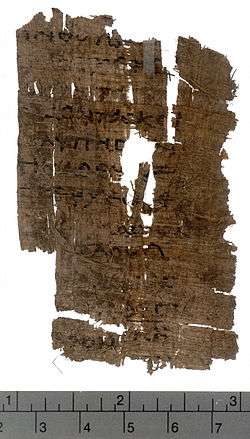Luke 22
| Luke 22 | |
|---|---|
 Luke 22:44-50 on fragments a and b (recto) of the codex 0171, written about AD 300. | |
| Book | Gospel of Luke |
| Bible part | New Testament |
| Order in the Bible part | 3 |
| Category | Gospel |
Luke 22 is the twenty-second chapter of the Gospel of Luke in the New Testament of the Christian Bible. It commences in the days just before the Passover or Feast of Unleavened Bread, and records the plot to kill Jesus Christ, the institution of the Lord's Supper, Jesus' arrest and his trial before the Sanhedrin.[1] The book containing this chapter is anonymous, but early Christian tradition uniformly affirmed that Luke composed this Gospel as well as the Acts of the Apostles.[2]
Text
- The original text is written in Koine Greek.
- Some most ancient manuscripts containing this chapter are:
- Papyrus 75 (written about AD 175-225)
- Papyrus 69 (3rd century; extant: verses 41,45-48, 58-61)
- Uncial 0171 (~AD 300; extant: verses 44-50,52-56,61,63-64)
- Codex Vaticanus (AD 325-350)
- Codex Sinaiticus (AD 330-360)
- Codex Bezae (ca. AD 400)
- Codex Washingtonianus (ca. AD 400)
- Codex Alexandrinus (ca. AD 400-440)
- Codex Ephraemi Rescriptus (ca. AD 450; extant: verses 1-18)
- This chapter is divided into 71 verses. It is the second longest chapter in the gospel in terms of the number of verses.[3]

Structure
The New King James Version organises this chapter as follows: (with cross references to other New Testament sections with similar contents):
- Luke 22:1-6 = Bargain of Judas
- Luke 22:1-2 = The Plot to Kill Jesus (Matthew 26:1-5; Mark 14:1-2; John 11:45-53)
- Luke 22:3-6 = Judas Betrayed Jesus (Matthew 26:14-16; Mark 14:10-11)
- Luke 22:7-38 = Last Supper (Matthew 26:17-35; Mark 14:12-31)
- Luke 22:7-13 = Jesus and His Disciples Prepare the Passover (Matthew 26:17-19; Mark 14:12-16)
- Luke 22:14-23 = Jesus Institutes the Lord’s Supper (Matthew 26:20-29; Mark 14:17-25; John 13:21-30; 1 Corinthians 11:23-25)
- Luke 22:24-30 = The Disciples Argue About Greatness
- Luke 22:31-34 = Jesus Predicts Peter's Denials (Matthew 26:31-35; Mark 14:27-31; John 13:36-38)
- Luke 22:35-38 = Supplies for the Road (Sell your cloak and buy a sword)
- Luke 22:39-46 = The Prayer in the Garden (Matthew 26:36-46; Mark 14:32-42)
- Luke 22:47-53 = Betrayal and Arrest in Gethsemane (Matthew 26:47-56; Mark 14:43-50; John 18:1-11)
- Luke 22:54-62 = Peter Denies Jesus, and Weeps Bitterly (Matthew 26:57-58,69-75; Mark 14:53-54,66-72; John 18:12-18,25-27)
- Luke 22:63-65 = Jesus Mocked and Beaten
- Luke 22:66-71 = Jesus Faces the Sanhedrin (Matthew 26:63-68; Mark 14:60-65; John 18:19-24)
Verses 14-38

Luke 22:14-38 has been described as "Jesus' farewell address", modeled after other farewell addresses in the Greco-Roman and biblical traditions.[4] Jesus declares to his apostles that "with fervent desire" (Greek: επιθυμια επεθυμησα (epithumia epithumesa) he has longed to celebrate this Passover with them. Pope Gregory X used these words as his text (Latin: Desiderio desideravi) at the Second Council of Lyons in 1274, in his sermon on the unity of the churches.[5]
Verses 40-42
- Pray that you will not fall into temptation (New International Version)
- Not my will, but yours, be done (New King James Version)
The words reflect Jesus' previous instructions to his disciples on how to pray (the Lord's Prayer, Luke 11:2-4), although the words "thy will be done, on earth as it is in heaven" do not appear in the earliest-known versions of Luke's Lord's Prayer.[6] The Pulpit Commentary suggests that "the temptation in question was the grave sin of moral cowardice into which so soon the disciples fell".[7]
Verses 43-44
The authenticity of Luke 22:43-44 has been disputed by scholars since the second half of the 19th century. The verses are placed in double brackets in modern editions of the Greek text, and listed in a footnote in the Revised Standard Version.
Verse 70
.jpg)
- All of them asked, “Are you, then, the Son of God?”
- He said to them, “You say that I am”. (New Revised Standard Version)
The New King James Version adds "rightly":
- “You rightly say that I am".[8]
Similarly, J. B. Phillips translates as:
- “You are right; I am,” Jesus told them.[9]
The Pulpit Commentary describes the style here as rabbinic: "by such an answer, the one interrogated accepts as his own affirmation the question put to him in its entirety."[7]
See also
- Gethsemane
- Hematidrosis
- Holy Week
- Jerusalem
- Last Supper
- Ministry of Jesus
- Sanhedrin
- Other related Bible parts: Psalm 41, Matthew 26, Mark 14, John 18, 1 Corinthians 11
References
- ↑ Halley, Henry H. Halley's Bible Handbook: an Abbreviated Bible Commentary. 23rd edition. Zondervan Publishing House. 1962.
- ↑ Holman Illustrated Bible Handbook. Holman Bible Publishers, Nashville, Tennessee. 2012.
- ↑ Chapter 1 has 80 verses
- ↑ Kurz, W. S. (1985), Luke 22:14-38 and Greco-Roman and Biblical Farewell Addresses, Journal of Biblical Literature, Vol. 104, No. 2 (June 1985), pp. 251-268, accessed 19 July 2018
- ↑ Catholic Encyclopedia (1913), Second Council of Lyons (1274), accessed 19 July 2018
- ↑ Pulpit Commentary on Luke 11, accessed 20 July 2018
- 1 2 Pulpit Commentary on Luke 22, accessed 20 July 2018
- ↑ Luke 22:70 - NKJV
- ↑ Luke 22:70 - J.B. Phillips' New Testament
External links
| Wikimedia Commons has media related to Gospel of Luke Chapter 22. |
| Wikisource has original text related to this article: |
| Preceded by Luke 21 |
Chapters of the Bible Gospel of Luke |
Succeeded by Luke 23 |